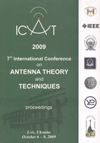Scattering properties of carbon nanotube antennas
DOI:
https://doi.org/10.1109/ICATT.2009.4435183Keywords:
carbon nanotube, CNT, nanovibrator, quantum resistance, collocation method, integral equationsAbstract
The boundary problem of diffraction and excitation of system of nanotubes-vibrators was reduced to solution of the integral equation (IE) with logarithmic kernel. After regularization the IEs were solved by means of collocation method considering th current’s behaviour at the vibrator's endings. The existence of resonances in the frequency range 0.1-1.0 THz was shown.References
HANSON, G.W. Fundamental Transmitting Properties of Carbon Nanotube Antennas. IEEE Trans. Antennas Propag., 2005, v.53, n.11, p.3426-3435.
HUANG, YI; YIN, WEN-YAN. Performance predication of carbon nanotube bundle dipole antenna. Proc. of Asia-Pacific Microwave Conf., 2007.
LERER, A.M.; KLESCHENKOV, A.B.; LERER, V.A.; LABUNKO, O.S. Radiotehnika I Elektronika, 2008, v.53, n.4, p.423-431.
KLESCHENKOV, A.B.; LERER, A.M.; MAKHNO, P.V.; MAKHNO, V.V. Electrodynamic analysis of carbon nanotube antenna. Proc. of 12th Int. Conf. on Mathematical Methods in Electromagnetic Theory, MMET-2008, Odesa, Ukraine. 2008.
Published
2009-10-10
Issue
Section
Analytical and numerical techniques

